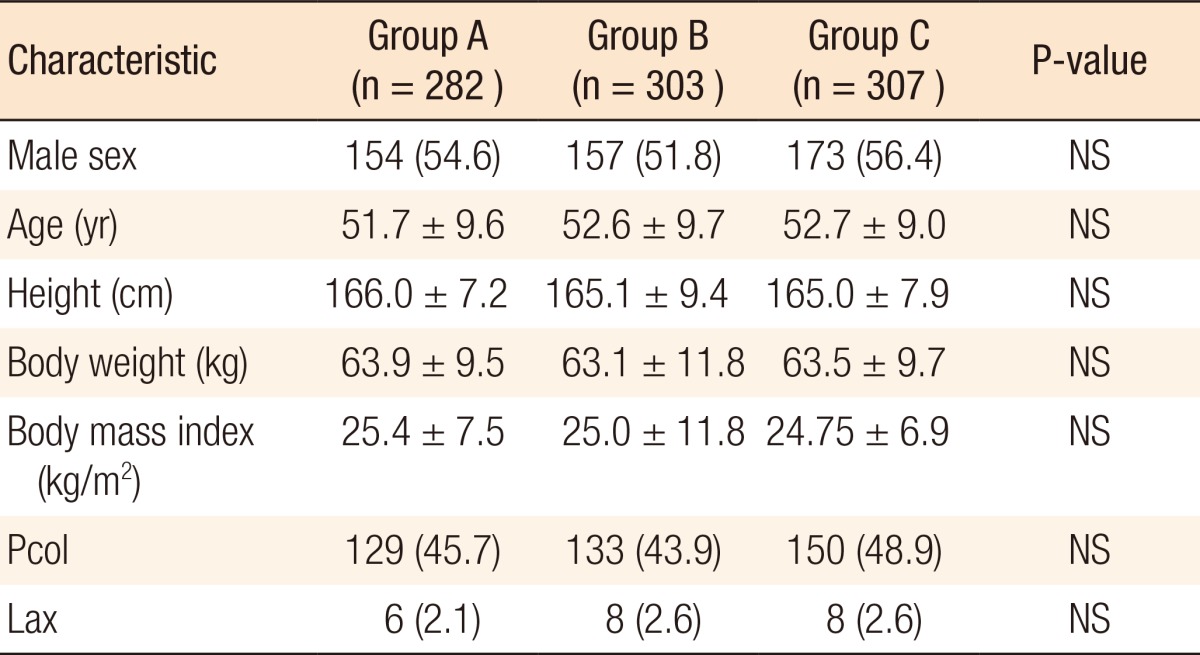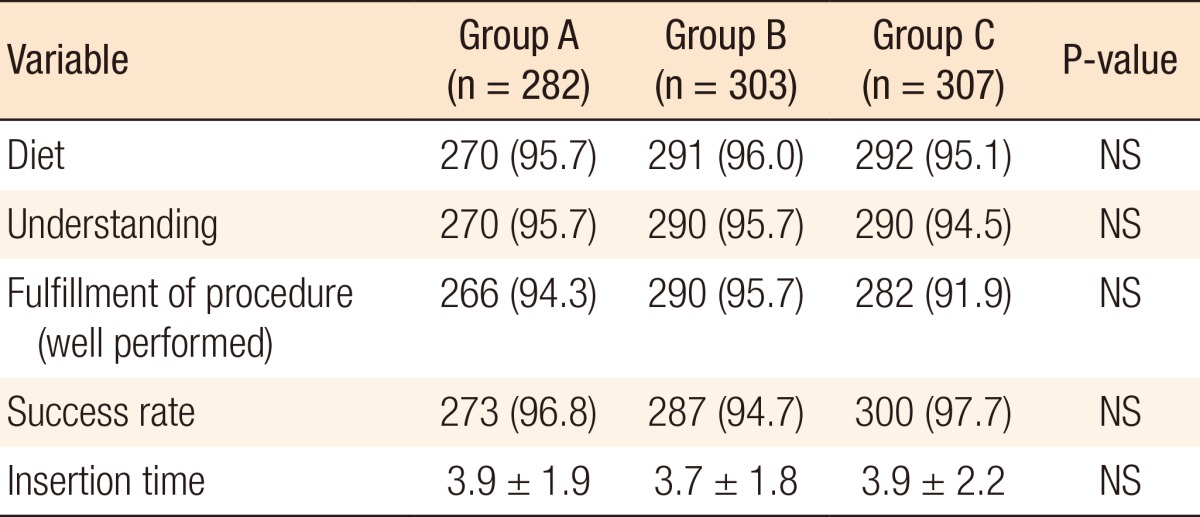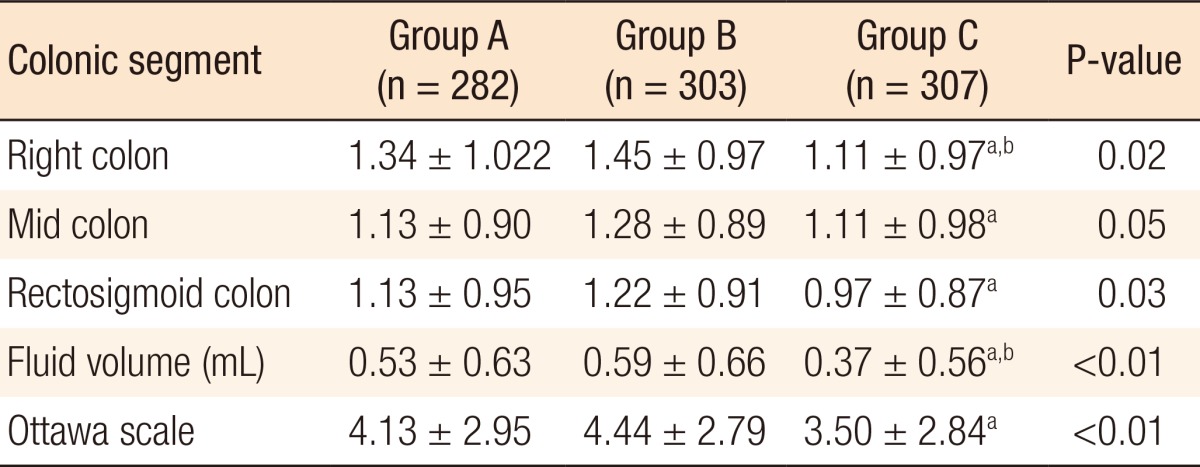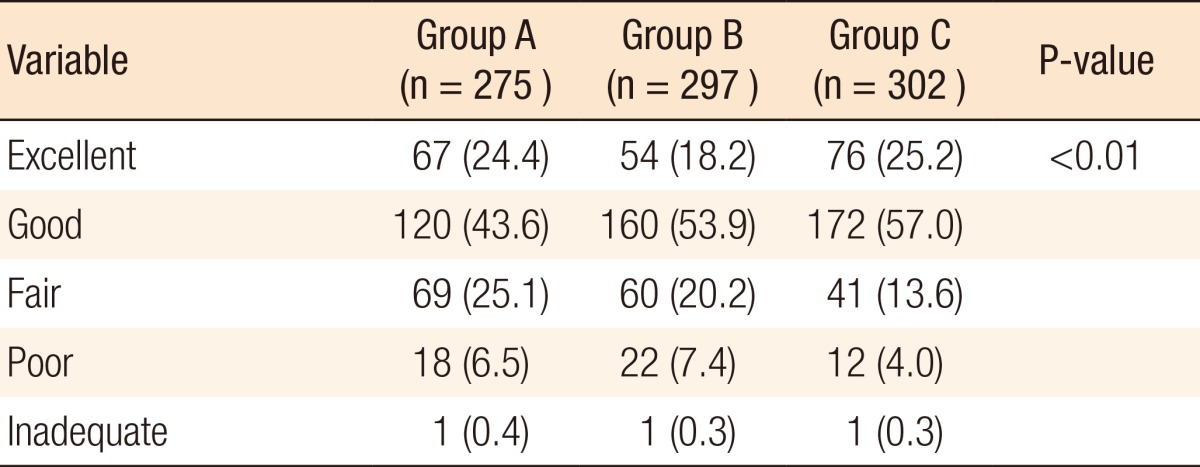1. Tan JJ, Tjandra JJ. Which is the optimal bowel preparation for colonoscopy: a meta-analysis. Colorectal Dis 2006;8:247–258. PMID:
16630226.


2. Hoy SM, Scott LJ, Wagstaff AJ. Sodium picosulfate/magnesium citrate: a review of its use as a colorectal cleanser. Drugs 2009;69:123–136. PMID:
19192941.


3. Love J, Bernard EJ, Cockeram A, Cohen L, Fishman M, Gray J, et al. A multicentre, observational study of sodium picosulfate and magnesium citrate as a precolonoscopy bowel preparation. Can J Gastroenterol 2009;23:706–710. PMID:
19826647.



4. Worthington J, Thyssen M, Chapman G, Chapman R, Geraint M. A randomised controlled trial of a new 2 litre polyethylene glycol solution versus sodium picosulphate + magnesium citrate solution for bowel cleansing prior to colonoscopy. Curr Med Res Opin 2008;24:481–488. PMID:
18179734.


5. Rostom A, Jolicoeur E. Validation of a new scale for the assessment of bowel preparation quality. Gastrointest Endosc 2004;59:482–486. PMID:
15044882.


6. Sharma VK, Steinberg EN, Vasudeva R, Howden CW. Randomized, controlled study of pretreatment with magnesium citrate on the quality of colonoscopy preparation with polyethylene glycol electrolyte lavage solution. Gastrointest Endosc 1997;46:541–543. PMID:
9434223.


7. Kim WH, Cho YJ, Park JY, Min PK, Kang JK, Park IS. Factors affecting insertion time and patient discomfort during colonoscopy. Gastrointest Endosc 2000;52:600–605. PMID:
11060182.


8. Huynh T, Vanner S, Paterson W. Safety profile of 5-h oral sodium phosphate regimen for colonoscopy cleansing: lack of clinically significant hypocalcemia or hypovolemia. Am J Gastroenterol 1995;90:104–107. PMID:
7801907.

9. Baik SJ, Shim KN, Na YJ, Kang MJ, Jung JM, Jung SA, et al. Hyponatremia with seizure and mental change after oral sodium phosphate bowel preparation: report of two cases. Korean J Gastrointest Endosc 2008;37:55–60.
10. Hookey LC, Vanner SJ. Pico-salax plus two-day bisacodyl is superior to pico-salax alone or oral sodium phosphate for colon cleansing before colonoscopy. Am J Gastroenterol 2009;104:703–709. PMID:
19223885.


11. Schmidt LM, Williams P, King D, Perera D. Picoprep-3 is a superior colonoscopy preparation to Fleet: a randomized, controlled trial comparing the two bowel preparations. Dis Colon Rectum 2004;47:238–242. PMID:
15043296.


12. Longcroft-Wheaton G, Bhandari P. Same-day bowel cleansing regimen is superior to a split-dose regimen over 2 days for afternoon colonoscopy: results from a large prospective series. J Clin Gastroenterol 2012;46:57–61. PMID:
22064553.


13. DiPalma JA, Marshall JB. Comparison of a new sulfate-free polyethylene glycol electrolyte lavage solution versus a standard solution for colonoscopy cleansing. Gastrointest Endosc 1990;36:285–289. PMID:
2365214.


14. Katz PO, Rex DK, Epstein M, Grandhi NK, Vanner S, Hookey LC, et al. A dual-action, low-volume bowel cleanser administered the day before colonoscopy: results from the SEE CLEAR II study. Am J Gastroenterol 2013;108:401–409. PMID:
23318484.


15. Flemming JA, Vanner SJ, Hookey LC. Split-dose picosulfate, magnesium oxide, and citric acid solution markedly enhances colon cleansing before colonoscopy: a randomized, controlled trial. Gastrointest Endosc 2012;75:537–544. PMID:
22192423.


16. Dillon CE, Laher MS. The rapid development of hyponatraemia and seizures in an elderly patient following sodium picosulfate/magnesium citrate (Picolax). Age Ageing 2009;38:487PMID:
19406975.

17. Rahman A, Vanner SJ, Baranchuk A, Hookey LC. Serial monitoring of the physiological effects of the standard Pico-Salax® regimen for colon cleansing in healthy volunteers. Can J Gastroenterol 2012;26:424–428. PMID:
22803016.



18. Turner D, Levine A, Weiss B, Hirsh A, Shamir R, Shaoul R, et al. Evidence-based recommendations for bowel cleansing before colonoscopy in children: a report from a national working group. Endoscopy 2010;42:1063–1070. PMID:
20669091.


19. Turner D, Benchimol EI, Dunn H, Griffiths AM, Frost K, Scaini V, et al. Pico-Salax versus polyethylene glycol for bowel cleanout before colonoscopy in children: a randomized controlled trial. Endoscopy 2009;41:1038–1045. PMID:
19967619.


20. Mc Laughlin P, Eustace J, Mc Sweeney S, Mc Williams S, O'Regan K, O'Connor M, et al. Bowel preparation in CT colonography: electrolyte and renal function disturbances in the frail and elderly patient. Eur Radiol 2010;20:604–612. PMID:
19727749.


21. Lawrance IC, Willert RP, Murray K. Bowel cleansing for colonoscopy: prospective randomized assessment of efficacy and of induced mucosal abnormality with three preparation agents. Endoscopy 2011;43:412–418. PMID:
21547879.















